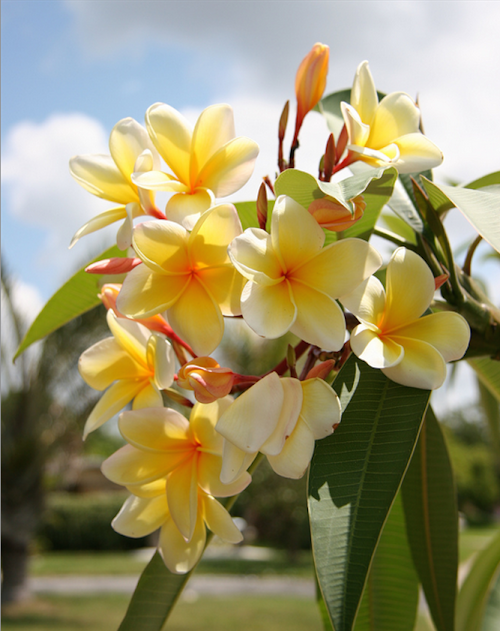
Most recognizable in their white and yellow frame, they likewise come in heaps of tropical and dusk hues, winding up more brilliant the nearer to the equator you go. Frangipanis are likewise intense plants that can survive disregard, warmth and dry season and still fill the garden with a superb scent. What more would you be able to request in a tree?
Description:Frangipanis are moderately little trees becoming just to around 5-6m in stature, yet what they need in tallness they make up in width frequently getting to be as wide as they are tall. They have a very much carried on root framework which makes them incredible for the home garden and for developing in pots. Frangipanis are likewise extraordinary survivors adapting to dry season, warmth, disregard and bug and vermin assault. They are likewise deciduous permitting most extreme winter sun while giving shade in summer.
With its contorted branches, long leaves and unmistakable blossoms, the frangipani is effortlessly a standout amongst the most well-known and identifiable trees. The bark is dark/green and textured in appearance. The scaling is framed when leaves drop in winter leaving little semi-round blemishes on the bark. The branches have a swollen appearance and the leaves, dim green on the best and a lighter shade of green underneath, group at the tips of branches. A cut made on any piece of the tree will ooze a smooth, sticky sap that is noxious to the two people and creatures.
Frangipani blossoms show up in groups, additionally toward the finish of the branches, and are particularly scented. The petals are waxy with the focal point of the bloom an alternate shading to the rest. For instance the most well-known frangipani has white blossoms with a yellow focus. There are numerous assortments running from profound dark red to orange , yellow and white (and each shade in the middle). Not at all like some blossoming trees which sprout for a couple of days or weeks, frangipanis continue blooming. Blossoms show up from December to April in Australia, and significantly longer in hotter atmospheres.
Varieties:Plumeria (basic name Frangipani) is a little class of 7-8 species local to tropical and subtropical Americas. The family comprises of predominantly deciduous bushes and trees. From Mexico and Central America, Plumeria has spread to every single tropical region of the world, particularly Hawaii, where it develops so plentifully that numerous individuals surmise that it is indigenous there.
Plumeria is identified with the Oleander (Nerium oleander) and both have toxic, smooth sap, somewhat like that of Euphorbia. Every one of the different types of Plumeria bears contrastingly molded leaves and their frame and development propensities are additionally unmistakable.
Plumeria Obtusa is a for the most part evergreen tree (decidous in dry seasons) with spreading branches and an adjusted arch. In spite of the fact that its basic name is "Singapore", it is initially from Colombia. Stature to 8m and spread to 4m. Leaves are indicated and oval up 18cm long. Tubular fragrant blooms happen in summer - pre-winter.
Plumeria Rubra (and variety Plumeria Acutifolia) otherwise called the Common Frangipani or Red Frangipani, is local to Mexico, Central America, and Venezuela. It is a decidous, spreading, scantily expanded tree or bush with a stature to 4m and spread to 4m and then some. Produces fragrant blooms with 5 spreading petals, extending from yellow to pink contingent upon shape or cultivar, in summer to fall. Leaves are spear molded to oval, and 20cm to 30cm long.
